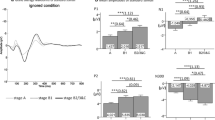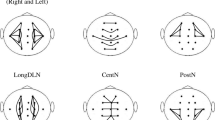Abstract
Eighteen males performed two vigilance tasks with static and dynamic stimuli under the influence of oxazepam (20 and 40 mg) in a placebo-controlled, double blind, crossover design. Oxazepam dose-dependently impaired overall level of performance and aggravated the decrement with time in measures of accuracy and sensitivity relative to placebo. The drug reduced the amplitudes of the P1, N1, P2N2, and P3 (dose-dependently) waves of event-related potentials (ERPs). Oxazepam aggravated the linear decline with time of the P3 amplitude only. Oxazepam impaired accuracy was related to deterioration of central processing involved in stimulus discrimination (P2N2). Impairment of response-related performance measures (RT and RI) was associated with processing manifest in the P1, N1, and P3 waves. Oxazepam effects on the amplitudes of N1 and P3 correlated with drug effects on power in alpha 1 (8–10 Hz). Drug effects on over-all performance and alpha were also related; the drug effect on response speed correlated only with the drug effect on beta 1 (12.5-21 Hz). Effects of time-on-task on performance and EEG were unrelated, but oxazepam induced performance declines with time may have been caused by declines in resource allocation, as manifest in the amplitude of P3. Time effects on EEG power bands and ERP amplitudes were not significantly related to the time course of oxazepam activity. A curious dissociation emerged: both oxazepam and time-on-task impaired performance, but the drug induced a decrease of theta and alpha 1 power, whereas time-on-task increased power. Various processes play a role in performance decrements with time, and various aspects of processing may be involved in signal-detection measures which makes terms such as sensitivity quite meaningless. So-called computational processing was indistinguishable from energetic processes, which questions the validity of the distinction between these two domains. Explanations of EEG activity in terms of a unidimensional theory of arousal are untenable.
Similar content being viewed by others
References
Başar E, Schürmann, Başar-Eroglu, Demiralp T (1994) Theta and delta responses in cognitive event-related potential paradigms and their possible psychophysiological correlates. In: Heinze H-J, Münte TF, Mangun GR (eds) Cognitive Electrophysiology. Birkhäuser, Boston, pp 334–367
Başar-Eroglu C, Başar E, Demiralp T, Schürmann M (1992) P300-response: possible psychophysiological correlates in delta and theta frequency channels. A review. Int J Psychophysiol 13:161–179
Beatty J, Greenberg A, Deibler WP, O'Hanlon JF (1974) Operant control of occipital theta rhythm affects performance in a radar monitoring task. Science 183:871–873
Bond A, Lader M, Shrotriya R (1983) Comparative effects of a repeated dose regime of diazepam and buspirone on subjective ratings, psychological tests and the EEG. Eur J Clin Pharmacol 24:463–467
Breimer LTM, Hennis PJ, Burm AGL, Danhof M, Bovill JG, Spierdijk J, Vletter AA (1990) Quantification of the EEG effect of midazolam by aperiodic analysis in volunteers. Pharmacokinetic/pharmacodynamic modelling. Clin Pharmacokin 18:245–253
Bruneau N, Roux S, Guérin P, Garreau B, Lelord G (1993) Auditory stimulus intensity responses and frontal midline theta rhythm. Electroencephalogr Clin Neurophysiol 86:213–216
Coppola R, Herrman WM (1987) Psychotropic drug profiles: comparisons by topographic maps of absolute power. Neuropsychobiology 18:97–104
Courchesne E, Hillyard SA, Galambos R (1975) Stimulus novelty, task relevance and the visual evoked potential in man. Electroencephalogr Clin Neurophysiol 39:131–143
Davies DR, Parasuraman R (1982) The psychology of vigilance. Academic Press, London
Dorow R (1984) Pharmacokinetic and clinical studies with a benzodiazepine radioreceptor assay. In: Hindmarch I, Ott H, Roth T (eds) Sleep, benzodiazepines and performance. Psychopharmacology [Suppl 1]. Springer, Berlin, pp 105–118
Finn JD (1978) Multivariance: user's guide. Version VI release 2. National Education Resources, Chicago
Floru R, Cail F, Elias R (1985) Psychophysiological changes during a VDU repetitive task. Ergonomics 28:1455–1468
Frey PW, Colliver JA (1973) Sensitivity and responsitivity measures for discrimination learning. Learn Motiv 4:327–342
Greenblatt DJ, Ehrenberg BL, Gunderman J, Locniskar A, Scavone JM, Harmatz JS, Shader RI (1989) Pharmacokinetic and electroencephalographic study of intravenous diazepam, midazolam and placebo. Clin Pharmacol Ther 45:356–365
Grier JB (1971) Non-parametric indexes for sensitivity and bias: computing formulas. Psychol Bull 79:424–429
Higgit A, Lader M, Fonagy P (1986) The effects of the benzodiazepine antagonist Ro 15-1788 on psychophysiological performance and subjective measures in normal subjects. Psychopharmacology 89:395–403
Horvath M, Frantick E, Kopriva K, Meissner J (1975) EEG theta activity increase coinciding with performance decrement in a monotonous task. Activ Nerv Super 18:207–210
Humphreys MS, Revelle W (1984) Personality, motivation, and performance: a theory of the relationship between individual differences and information processing. Psychol Rev 91:153–184
Intriligator J, Polich J (1994) On the relationship between background EEG and the P300 event-related potential. Biol Psychol 37:207–218
Isreal JB, Wickens C, Chesney GL, Donchin E (1980) The eventrelated brain potential as an index of display-monitoring workload. Hum Fact 22:211–224
Jasiukaitis P, Hakerem G (1988) The effect of pre-stimulus alpha activity on the P300. Psychophysiology 25:157–165
Katznelson RD (1981) EEG recording, electrode placement, and aspects of generator localization. In: Nunez PL (ed) Electrical fields of the brain. University Press, New York, pp 176–213
Kenemans JL, Verbaten MN, Roelofs JW, Slangen JL (1989) “Initial-” and “change-ORs”. An analysis based on visual single-trial event- related potentials. Biol Psychol 28:199–226
Kenemans JL, Verbaten MN, Melis CJ, Slangen JL (1992) Visual stimulus change and the orienting reaction: event-related potential evidence for a two-stage process. Biol Psychol 33:97–114
Koelega HS (1989) Benzodiazepines and vigilance performance: a review. Psychopharmacology 98:145–156
Koelega HS (1991) Studies of human vigilance performance. Thesis, University of Utrecht
Koelega HS (1993) Stimulant drugs and vigilance performance: a review. Psychopharmacology 111:1–16
Koelega HS, Verbaten MN (1991) Event-related brain potentials and vigilance performance: a review. Percept Mot Skills 72:971–982
Koelega HS, Verbaten MN, Van Leeuwen TH, Kenemans JL, Kemner C, Sjouw W (1992) Time effects on event-related potentials and vigilance performance. Biol Psychol 34:59–86
Makeig S, Inlow M (1992) Lapses in alertness: coherence of fluctuations in performance and EEG spectrum. Electroencephalogr Clin Neurophysiol 86:23–35
Mandema JW (1991) EEG effect measures and relationships between pharmacokinetics and pharmacodynamics of psychotropic drugs. Thesis, University of Leiden
Manmaru S, Matsuura M (1989) Quantification of benzodiazepineinduced topographic EEG changes by a computerized wave form recognition method: application of a principle component analysis. Electroencephalogr Clin Neurophysiol 72:126–132
Milosevic S (1978) Vigilance performance and the amplitude of EEG activity. Ergonomics 21:887–889
Mizuki Y, Tanaka M, Isozaki H, Nishijima H, Inanaga K (1980) Periodic appearance of theta rhythm in the frontal midline area during performance of a mental task. Electroencephalogr Clin Neurophysiol 49:345–351
Näätänen R, Gaillard AWK (1983) The orienting reflex and the N2 deflection of the event-related potential (ERP). In: Gaillard AWK, Ritter W (eds) Tutorials in ERP research: endogeneous components. North-Holland, Amsterdam, pp 119–141
Näätänen R, Picton TW (1987) The N1 wave of the human electric and magnetic response to sound: A review and an analysis of the component structure. Psychophysiology 24:375–425
Ogilvie RD, Simons IA, Kuderian RH, MacDonald T, Rustenburg J (1991) Behavioral, event-related potential, and EEG/FFT changes at sleep onset. Psychophysiology 28:54–64
O'Hanlon JF, Beatty J (1977) Concurrence of electroencephalographic and performance changes during a simulated radar watch and some implications for the arousal theory of vigilance. In: Mackie RR (ed) Vigilance: theory, operational performance and physiological correlates. Plenum, New York, pp 189–201
Ossenblok P (1992) The sources of the pattern VEP in man. Thesis, University of Amsterdam
Ott H (1984) Are electroencephalographic and psychomotor measures sensitive in detecting residual sequelae of benzodiazepine hypnotics? In: Hindmarch I, Ott H, Roth T (eds) Sleep, benzodiazepines and performance. Psychopharmacology [Suppl 1]. Springer, Berlin pp 133–151
Parasuraman R (1985) Event-related brain potentials and intermodal divided attention. Proc Hum Fac Soc 29th Annual Meeting, pp 971–975
Patat A, Klein MJ, Hucher M, Granier J (1990) Computer-analysed EEG and psychometric assessment of two new non-benzodiazepine tranquillizers in healthy volunteers. Hum Psychopharmacol 5:123–131
Pribram KH, McGuiness D (1975) Arousal, activation and effort in the control of attention. Psychol Rev 82:116–149
Ray WJ, Cole HW (1985) EEG alpha activity reflects attentional demands, and beta reflects emotional and cognitive processes. Science 228:750–752
Ruchkin DS, Sutton S, Kietzman ML, Silver K (1980) Slow wave and P300 in signal detection. Electroencephalogr Clin Neurophysiol 50:35–47
Saletu B, Grünberger J, Linzmayer L (1986) Pharmacokinetic and dynamic studies with a new anxiolytic imidazo-pyridine alpidem utilizing pharmaco-EEG and psychometry. Int Clin Psychopharmacol 1:145–164
Sanders AF (1986) Energetical states underlying task performance. In: Hockey GRJ, Gaillard AWK, Coles MGH (eds) Energetics and human information processing. Martinus Nijhoff, Dordrecht, pp 139–174
Skinner JE, Yingling CD (1977) Central gating mechanisms that regulate event-related potentials and behavior: A neural model for attention. In: Desmedt JE (ed) Progress in clinical neurophysiology: vol 1, Attention, voluntary contraction and eventrelated cerebral potentials. Karger, Basel, pp 30–69
Sternberg S (1969) On the discovery of processing stages: some extensions of Donder's method. Acta Psychol 30:267–315
Valentino DA, Arruda JE, Gold SM (1993) Comparison of QEEG and response accuracy in good vs poorer performers during a vigilance task. Int J Psychophysiol 15:123–133
Van Leeuwen TH, Verbaten MN, Koelega HS, Kenemans JL, Slangen JL (1992) Effects of bromazepam on single trial event-related brain potentials in a visual vigilance task. Psychopharmacology 106:555–564
Van Leeuwen TH, Verbaten MN, Koelega HS, Camfferman G, Van der Gugten J, Slangen JL (1994a) Effects of oxazepam on eye movements and performance in vigilance tasks with static and dynamic stimuli. Pscyhopharmacology 114:109–118
Van Leeuwen TH, Verbaten MN, Koelega HS, Camfferman G, Van der Gugten J, Slangen JL (1994b) Effects of oxazepam on performance and event-related brain potentials in vigilance tasks with static and dynamic stimuli. Psychopharmacology 116:499–507
Wickens CD (1984) Processing resources in attention. In: Parasuraman R, Davies DR (eds) Varieties of attention. Academic Press, Orlando, Fla. pp 63–102
Woestenburg JC, Verbaten MN, Slangen JL (1983a) The removal of the eye movement artifact from the EEG by regression analysis in the frequency domain. Biol Psychol 16:127–147
Woestenburg JC, Verbaten MN, Van Hees HH, Slangen JL (1983b) Single-trial ERP estimation in the frequency domain using orthogonal polynomial trend analysis (OPTA): estimation of individual habituation. Biol Psychol 17:173–191
Author information
Authors and Affiliations
Rights and permissions
About this article
Cite this article
van Leeuwen, T.H., Verbaten, M.N., Koelega, H.S. et al. Effects of oxazepam on event-related brain potentials, EEG frequency bands, and vigilance performance. Psychopharmacology 122, 244–262 (1995). https://doi.org/10.1007/BF02246546
Received:
Revised:
Issue Date:
DOI: https://doi.org/10.1007/BF02246546




